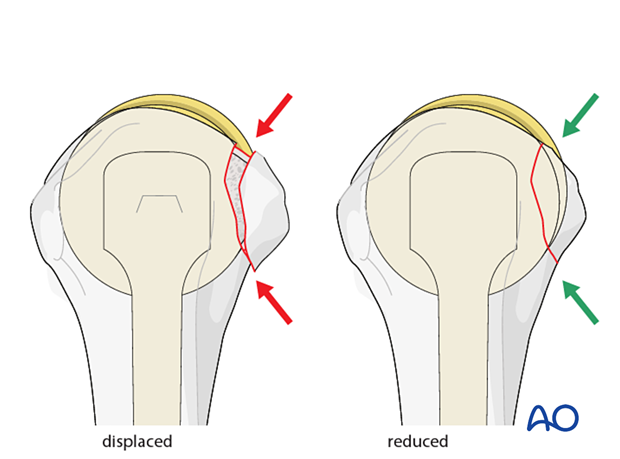ORIF - Plate fixation
1. Principles
The lesser tuberosity is typically displaced anteriorly due to the pull of the subscapularis.
The displaced lesser tuberosity must be reduced and fixed stably (for anatomical shoulder prostheses).
More information about fixation of this fracture type can be found in the AO Surgery Reference Proximal humerus module.

A plate can be used to buttress a lesser tuberosity fragment to increase the stability of a suture fixation. This can be a one-third tubular plate or a 2.7 mm adaptation plate. An example of a completed construct is shown in this illustration.

Suture reduction and fixation of the lesser tuberosity
Sutures in the subscapularis tendon insertion aid manipulation, reduction, and temporary fixation of a lesser tuberosity fracture.
Traction on the sutures helps achieve reduction. When tied, they bring the fragments together and stabilize them.

Neutralizating sutures in addition to plate and screws
Sutures placed through the insertions of the subscapularis tendon are the principal fixation technique. With osteoporotic bone, the tendon insertion is often stronger than the bone itself, so that sutures placed through the insertional fibers of the tendon may hold better than screws or sutures placed through bone.
This form of fixation was referred to as a “Tension band suture fixation”. We now prefer the term “Neutralizing suture” because the tension band mechanism cannot be applied consistently to each component of the fracture fixation. An explanation of the limits of the Tension band mechanism/principle can be found here.
In larger lesser tuberosity fragments, especially with extension to the metaphyseal humerus, a buttress plate can be used to increase stability.

2. Patient preparation and approaches
Patient preparation
It is recommended that this procedure is performed with the patient in a beach chair position.
Patient positioning should be discussed with the anesthetist.

Approach
The approach of choice is the deltopectoral approach.

3. Reduction and preliminary fixation
Place rotator cuff sutures
Subscapularis tendonSutures are inserted into the subscapularis tendon medial to the osteotendinous junction. These provide guides for reduction and temporary fixation of the lesser tuberosity.

Reduce the lesser tuberosity
Traction on the sutures in the subscapularis tendon aids reduction of the lesser tuberosity.
A periosteal elevator may help to manipulate the lesser tuberosity.

Preliminary fixation of the lesser tuberosity
The transverse sutures are tightened and tied to achieve preliminary fixation of the lesser tuberosity fragment.

Confirm reduction
After preliminary fixation the reduction is checked visually and with image intensification.
All fracture lines should remain closed without steps or gaps between the greater and lesser tuberosities during rotation of the arm. This should be further assessed by image intensification.

4. Plate fixation
Attach the plate to the humeral shaft
An adaptation plate is provisionally fixed to the humeral shaft with a bicortical 2.7 mm cortical screw (a 3.5 mm screw if a one-third tubular plate is applied).
- If the first screw is inserted loosely in the center of the elongated hole, it is still possible to fine-tune the plate position. Once the plate is in the proper position, the screw can be definitively tightened.
- The plate can be adapted in situ to the contour of the lesser tuberosity to act as a buttress plate and as a spring plate, resisting displacement of the lesser tuberosity.

Insert additional screws into the humeral shaft
One or two additional bicortical screws are inserted into the humeral shaft. As the stem needs to be avoided, drill obliquely anterior and/or posterior to the stem. It is preferable to position screws both anterior and posterior to the stem.

5. Final check of osteosynthesis
The C-arm must be directed to allow orthogonal views. Position the arm as necessary to confirm that reduction is satisfactory, fixation is stable, and the screws are of appropriate length.

6. Aftercare
Postoperative phases
The aftercare can be divided into four phases of healing:
- Inflammatory phase (week 1–3)
- Early repair phase (week 4–6)
- Late repair and early tissue remodeling phase (week 7–12)
- Remodeling and reintegration phase (week 13 onwards)
Full details on each phase can be found here.













